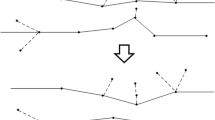Abstract
We consider the problem of allocating scarce resources to repair a rural road network after it has been damaged by a natural or man-made disaster. We propose a solution approach based on the GRASP and VNS metaheuristics that aims to maximize the accessibility of as many people as possible to the main cities or regional centers where the economic and social infrastructure is usually located. The efficiency of our approach is demonstrated by applying it to a set of small and medium size instances and to a large real-life motivated instance. Results point out the importance of OR techniques to support the disaster management decision process operations, particularly during the recovery phase.
Similar content being viewed by others
References
Altay N, Green W (2006) OR/MS research in disaster operations management. Eur J Oper Res 175: 475–493
Antunes A, Seco A, Pinto N (2003) An accessibility-maximization approach to road network planning. Comput-Aided Civil Infrastruct Eng 18: 224–240
Bertsekas D (1998) Network optimization. Continuous and discrete models, chap 2. The shortest path problem. Athena Scientific, pp 51–114
Campbell A, Lowe T, Zhang L (2006) Upgrading arcs to minimize the maximum travel time in a network. Networks 47: 72–80
Chen Y, Tzeng G (1999) A fuzzy multi-objective model for reconstructing post-earthquake road-network by genetic algorithm. Int J Fuzzy Syst 2: 85–95
Donnges C (2003) Improving access in rural areas: guidelines for integratedrrural accessibility planning. Technical report, International Labour Organization
Ergun O, Karakus G, Keskinocak P, Swann J, Villarreal M (2010) Operations research to improve disaster supply chain management. Wiley Encyclopedia of Operations Research and Management Science, 8
Feng C, Wang T (2003) Highway emergency rehabilitation scheduling in post-earthquake 72 hours. J Eastern Asia Soc Transp Stud 5: 3276–3285
Festa P, Resende M (2009) An annotated bibliography of GRASP. Part II: applications. Int Trans Oper Res 16: 131–172
Hansen P, Mladenovic N (2005) Search methodologies. Introductory tutorials in optimization and decision support techniques. Variable neighborhood search. Springer, New York, pp 211–238
Hu TC, Shing MT (2002) Combinatorial algorithms, chap 1. Shortest paths. Dover, pp 10–16
Karlaftis M, Kepaptsoglou K, Lambropoulos S (2007) Fund allocation for transportation network recovery following natural disasters. J Urban Plan Dev 133: 82–89
Krumke S, Marathe M, Noltemeier H, Ravi R, Ravi S (1998a) Approximation algorithms for certain network improvement problems. J Combin Optim 2: 257–288
Krumke S, Marathe M, Noltemeier H, Ravi R, Ravi S (1998b) Network design: connectivity and facilities location. Network improvement problems. American Mathematical Society, pp 247–268
Lebo J, Schelling D (2001) Design and appraisal of rural transport infrastructure ensuring basic access for rural communities. Technical report, World Bank
Moe T, Pathranarakul P (2006) An integrated approach to natural disaster management: public project management and its critical success factors. Disaster Prev Manag 15: 396–413
Murawski L, Church R (2009) Improving accessibility to rural health services: the maximal covering network improvement problem. Socio-Econ Plan Sci 43: 102–110
OCHA-UN (2008) Haiti flash appeal 2008. Technical report. Office for the cordination of humanitarian affairs
OMP (2009) WFP-assisted development projects, protracted relief and emergency operations. Technical report. The Regional Bureau for Latin America and the Caribbean
Opricovic S, Tzeng G (2002) Multicriteria planning of post-earthquake sustainable reconstruction. Comput-Aided Civil Infrastruct Eng 17: 211–220
Resende M, Ribeiro C (2010) Greedy randomized adaptive search procedures: advances and applications. In: Handbook of metaheuristics, 2nd edn. Springer, New York, pp 281–317
Scaparra M, Church R (2005) A GRASP and path relinking heuristic for rural road network development. J Heuristics 11: 89–108
Twigg J (2004) Good practice review 9. Disaster risk reduction: mitigation and preparedness in aid programming. Overseas Development Institute
UN/ISDR (2002) Living with risk: a global review of disaster reduction initiatives. Preliminary version. Technical report, ISDR Secretariat
Van Wassenhove L (2003) New interesting POM cases from Europe. POMSChronicle 10: 19
Yan S, Shih Y (2009) Optimal scheduling of emergency roadway repair and subsequent relief distribution. Comput Oper Res 36: 2049–2065
Author information
Authors and Affiliations
Corresponding author
Rights and permissions
About this article
Cite this article
Maya Duque, P., Sörensen, K. A GRASP metaheuristic to improve accessibility after a disaster. OR Spectrum 33, 525–542 (2011). https://doi.org/10.1007/s00291-011-0247-2
Published:
Issue Date:
DOI: https://doi.org/10.1007/s00291-011-0247-2




